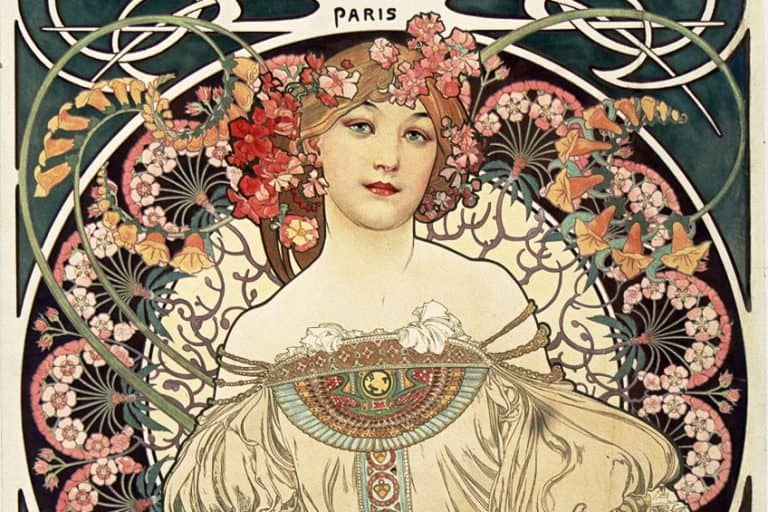Famous Contemporary Sculptors – Explore Modern Art Sculptures
Contemporary sculpture artists have contributed immensely to the world of art with their stunning creations that captivate the audience with their sheer brilliance. Modern art sculptures, in particular, have become increasingly popular over the years, and their influence can be seen in public spaces, museums, and galleries around the world. From the avant-garde to the classic, the field of contemporary sculpture has witnessed some of the most iconic and innovative works of art. In this article, we will delve into the world of modern sculptors and highlight some of the most famous contemporary sculptures that have left a lasting impact on the art world.
Famous Contemporary Sculptors
Sculpture has been an integral part of human expression for thousands of years, with ancient civilizations producing some of the most iconic works of art that continue to inspire contemporary artists. However, it was during the modern era that sculpture underwent a radical transformation, with artists pushing the boundaries of the medium by experimenting with new materials, techniques, and styles.
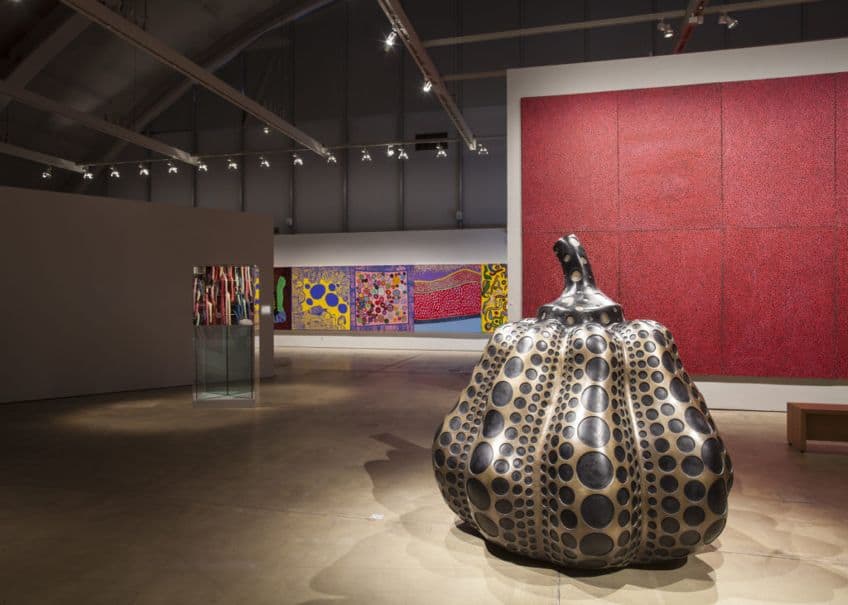
In the late 19th century, sculptors such as Auguste Rodin (1840-1917) and Constantin Brancusi (1876-1957) pioneered new approaches to form and abstraction, setting the stage for a new era of modern sculpture. This was followed by the emergence of avant-garde movements such as Cubism and Futurism, which rejected traditional forms in favor of more experimental and abstract compositions. Today, modern sculpture continues to evolve, with artists constantly pushing the limits of what is possible with this versatile medium.
Let us look at 10 famous contemporary sculptors that have continued to build on this rich tradition of expression.
Louise Bourgeois (1911 – 2010)
| Date of Birth | 1911 |
| Date of Death | 2010 |
| Nationality | French-American |
| Famous Artworks | Spider (1994), Cell (1989 – 1993), and Maman (1999 – 2002) |
| Performance Themes | The unconscious mind, sexual passion, envy, disloyalty, fear, anxiety, loneliness, and the body |
Louise Bourgeois (1911 – 2010) was a French-American artist whose career spanned over seven decades. She is widely considered as one of the most influential artists of the 20th century, particularly in the realm of sculpture and installation art. Bourgeois explored themes of femininity, sexuality, and the body in her work, often using unconventional materials such as rubber, fabric, and found objects. Her pieces are known for their emotional intensity, psychological complexity, and raw physicality.

Bourgeois received numerous accolades throughout her practice, including a retrospective at the Museum of Modern Art in New York in 1982. In 2007 she was also the first female creative that did a major exhibition of all the work she had created up until that point in her career at the Tate Modern in London. Her legacy continues to influence contemporary artists today.
Why Is Louise Bourgeois Such an Influential Modern Sculptor?
Louise Bourgeois is considered one of the most influential modern sculptors due to the originality and impact of her work. She challenged traditional notions of sculpture by experimenting with strange materials and exploring controversial themes such as sexuality, womanhood, and the human psyche.
Her emotionally charged and psychologically complex pieces have left an indelible mark on the art world, inspiring subsequent generations of artists.
Bourgeois’ groundbreaking sculptures and installations have been exhibited in major museums and galleries around the world, and her innovative approach to the medium has helped redefine the boundaries of sculpture as a discipline. Bourgeois’ influence continues to be felt in contemporary art today, solidifying her status as a trailblazing artist whose contributions will be celebrated for generations to come.
Modern Art Sculpture Example: Maman (1999 – 2002)
Maman is a striking and thought-provoking sculpture that immediately captures the viewer’s attention. The sculpture features a towering bronze spider that stands over nine meters tall, with elongated legs that sprawl across the ground. At once fearsome and fascinating, the spider’s menacing presence is softened by the inclusion of delicate, egg-shaped sacs that hang from its underbelly. Bourgeois’ use of the spider as a symbol of the maternal is evident in the title of the work, “Maman,” which translates to “Mother” in French.
The sculpture explores themes of motherhood, femininity, and protection, as the spider’s maternal instincts are juxtaposed with its fearsome appearance. Through the use of scale, material, and symbolism, Bourgeois creates a complex and multi-layered work that invites the viewer to engage with its themes on both a visual and conceptual level.
Yayoi Kusama (1929 – Present)
| Date of Birth | 1929 |
| Date of Death | N/A |
| Nationality | Japanese |
| Famous Artworks | Dots Obsession (2003), Infinity Mirror Room (1965 – Present), and Ascension of Polka Dots (2006) |
| Performance Themes | Human psyche, feminism, fixation, sex, creation, demolition, and fierce self-reflection |
Yayoi Kusama is a Japanese artist who has made a significant impact on the international art world since the 1960s. Her work spans a variety of mediums, including painting, sculpture, performance, and installation art, and is characterized by vibrant colors, intricate patterns, and bold, repetitive motifs.
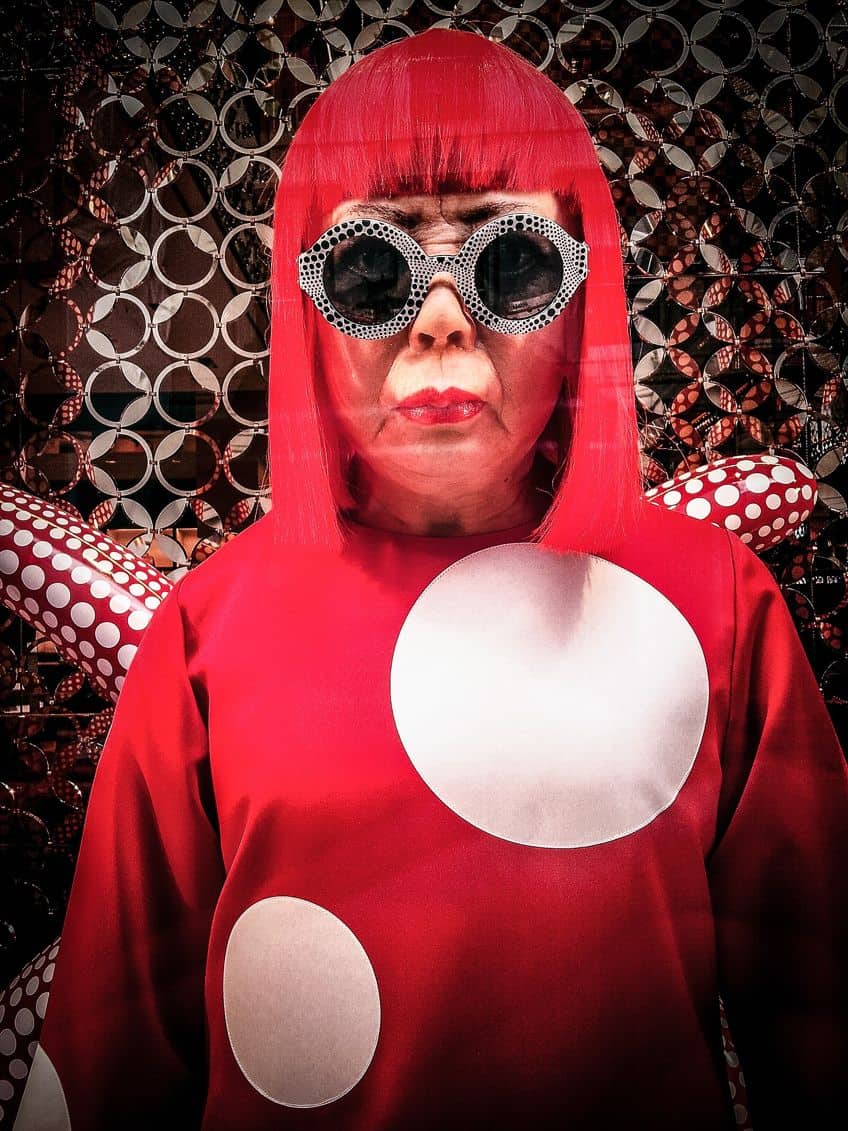
Kusama’s art explores themes of infinity, obsession, and the human condition, often utilizing her own personal struggles with mental health to inform her work. Kusama’s work has been exhibited in major museums and galleries globally, and she continues to inspire new generations of artists with her visionary approach to art-making.
Why Is Yayoi Kusama Such an Influential Contemporary Sculpture Artist?
Yayoi Kusama is an influential contemporary sculpture artist who has made a significant impact on the art world due to the originality and power of her work. Her innovative use of different media, particularly installation art, has helped redefine what sculpture can be in the contemporary era.
Kusama’s use of repetition, bold colors, and abstract forms creates immersive, mesmerizing experiences that transport viewers beyond the realm of the ordinary.
Her art explores themes of infinity, the subconscious, and personal experience, creating a deeply moving connection with the audience. Kusama’s influence extends beyond the realm of sculpture, with her iconic polka-dot patterns and other motifs finding their way into fashion, design, and popular culture. Kusama’s innovative art has left an indelible impact on contemporary art and culture.
Famous Contemporary Sculpture Example: Infinity Mirror Room (1965 – Present)
Infinity Mirror Room by Yayoi Kusama is a mesmerizing installation that immerses viewers in a seemingly infinite space. The room is lined with mirrored walls and features an array of lights that are reflected infinitely, creating an otherworldly, dreamlike atmosphere. The use of repetition and pattern creates a sense of infinity and the illusion of the viewer being lost in a never-ending universe.

The work explores themes of infinity and the subconscious, reflecting Kusama’s fascination with the cosmos and the infinite possibilities of the human psyche. The installation invites the viewer to engage with the work on both a visual and conceptual level, creating a meditative and introspective experience.
Richard Serra (1938 – Present)
| Date of Birth | 1938 |
| Date of Death | N/A |
| Nationality | American |
| Famous Artworks | Tilted Arc (1981), The Hedgehog and the Fox (1999), and Wake (2004) |
| Performance Themes | Weight, gravity, expanse, method, and time |
Richard Serra is an American minimalist sculptor known for his massive, location-specific steel structures. Serra studied art at Yale University and later at the University of California, Santa Barbara. His early work focused on process art and conceptualism, but he gained widespread recognition in the 1960s and 1970s for his minimalist sculptures, which emphasized the physical properties of materials and the viewer’s experience of space.
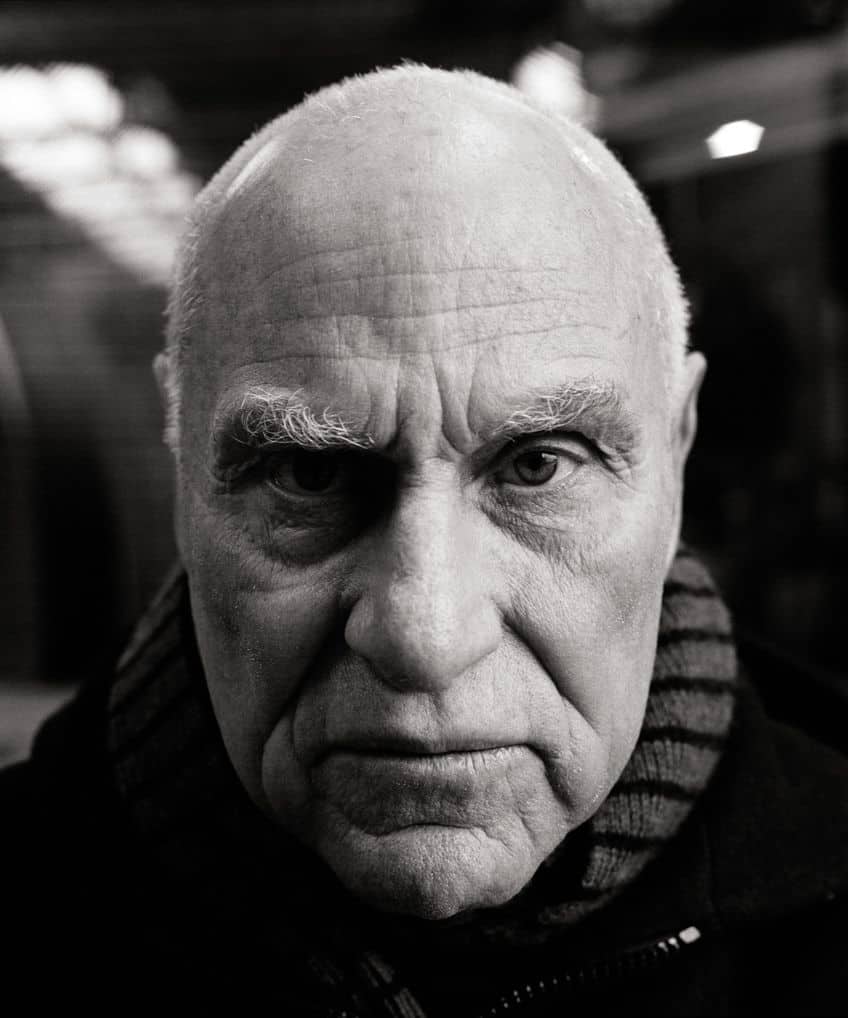
Serra’s work is characterized by its monumental scale, industrial materials, and emphasis on the relationship between the viewer and the surrounding environment. His sculptures are installed in public spaces and museums around the world, and he is widely seen as one of the most significant sculptors of his epoch.
Why Is Richard Serra Such an Influential Contemporary Sculpture Artist?
Richard Serra’s work is highly influential in contemporary sculpture due to his innovative approach to materiality and space. His large-scale steel sculptures challenge traditional notions of sculpture, as they often occupy entire rooms or outdoor spaces, and invite the viewer to interact with them in a physical and experiential way. Serra’s sculptures also emphasize the importance of site-specificity and context, as he carefully considers the location and surroundings of each work in relation to its meaning and impact.
His work has inspired a new generation of sculptors and continues to push the boundaries of what sculpture can be in the 21st century.
Famous Contemporary Sculpture Example: Cycle (2011)
Cycle (2011) by Richard Serra is a monumental sculpture composed of five towering steel plates that arc and curve around each other, creating a dynamic and immersive space. The towering plates, which each weigh over 16 tons, are arranged in a cyclical formation, inviting the viewer to walk through and around the sculpture.
Serra’s work is known for its emphasis on materiality and the viewer’s experience of space, and Cycle is no exception. The sculpture’s size and weight make it a physical presence in the surrounding environment, while the curving plates create a sense of movement and flow. The interplay of light and shadow on the steel surfaces adds to the sculpture’s visual impact, creating a complex and engaging experience for the viewer.
Isa Genzken (1948 – Present)
| Date of Birth | 1948 |
| Date of Death | N/A |
| Nationality | German |
| Famous Artworks | Rose (1993), Bouquet (2004), and Untitled (2006) |
| Performance Themes | The relation between personal and public realm, the independence of art, and the collective experience |
Isa Genzken is a contemporary German sculptor who has had a significant impact on the art world since the 1970s. Her work is characterized by a bold and unconventional approach, using a wide range of materials and techniques to explore themes of identity, consumer culture, and urbanism. Genzken’s sculptures often challenge the traditional boundaries of sculpture, blurring the lines between art and architecture, and incorporating everyday objects like mannequins, photographs, and mirrors.
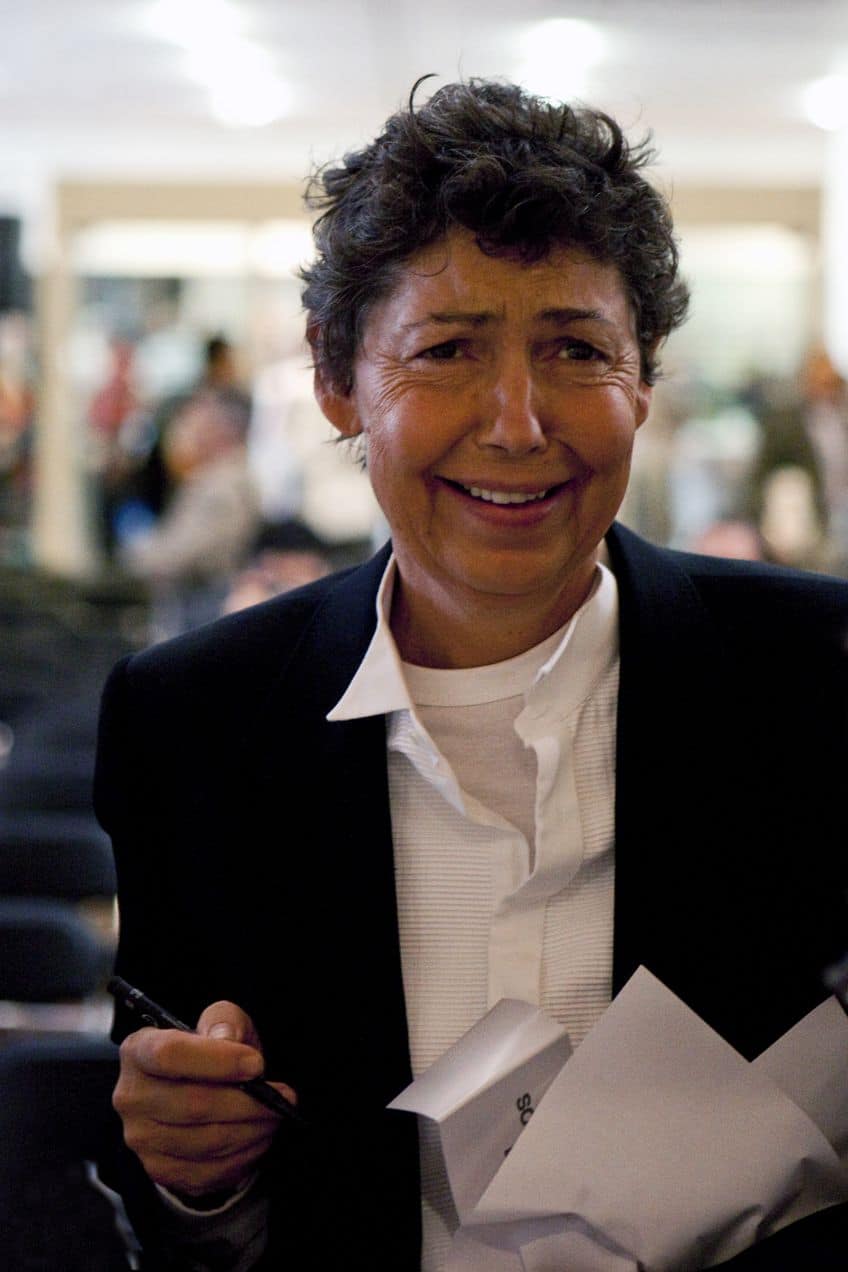
Her art has been exhibited in prominent galleries and museums around the globe, including the MOMA in New York, and has been the subject of multiple retrospectives. Genzken’s innovative approach to sculpture has influenced a new generation of artists and has helped to redefine the possibilities of contemporary sculpture.
Why Is Isa Genzken Such an Influential Contemporary Sculpture Artist?
Isa Genzken’s unconventional and boundary-pushing approach to sculpture has had a significant impact on the contemporary art world. Her willingness to experiment with a wide range of materials and techniques, as well as her ability to incorporate everyday objects into her work, has helped to redefine the possibilities of sculpture.
Genzken’s work explores themes of identity, consumer culture, and urbanism, challenging traditional notions of what art should be and pushing the boundaries of the medium.
Her influence can be seen in the work of many contemporary sculptors, who have been inspired by her innovative approach and willingness to push the limits of the medium. Genzken’s work is a testament to the power of experimentation and innovation in art, and her impact on contemporary sculpture cannot be overstated.
Modern Art Sculpture Example: Bouquet (2004)
Bouquet (2004) by Isa Genzken is a striking sculpture that resembles a floral arrangement. The bouquet is made up of various materials, including wood, plaster, plastic, and fabric, and stands at an impressive 2.6 meters tall. At first glance, the piece appears almost chaotic, with its mixture of colors and textures, but upon closer inspection, a careful organization emerges.
The individual elements of the bouquet are arranged in such a way as to create a dynamic tension between the organic and the artificial. The sculpture challenges our perception of what a bouquet should be, while simultaneously drawing our attention to the beauty that can be found in the unexpected. Genzken’s Bouquet is an example of her ability to explore the boundaries between the natural and the constructed, and the ways in which our understanding of these concepts is constantly shifting.
Kiki Smith (1954 – Present)
| Date of Birth | 1954 |
| Date of Death | N/A |
| Nationality | German American |
| Famous Artworks | Rapture (2001), Alice II (feet uncrossed) (2005), and Annunciation (2008) |
| Performance Themes | Female body, gender, mortality, sexuality, and nature |
Kiki Smith is a contemporary American artist known for her sculpture, printmaking, and drawing. Born in Germany in 1954 and raised in the United States, Smith has become one of the most influential feminist artists of her generation. Her work often deals with issues of gender, mortality, and the human body, and is characterized by its use of unconventional materials and techniques.

Throughout her career, Smith has been the recipient of multiple prizes and tributes, including the Skowhegan Medal for Sculpture and the U.S. State Department Medal of Arts. She has exhibited her work in galleries and museums around the world, and her pieces can be found in the collections of many prominent institutions, among these she was included in the collection of MOMA in New York and the Centre Georges Pompidou in Paris.
Why Is Kiki Smith Such an Influential Contemporary Sculpture Artist?
Kiki Smith’s influential role in contemporary sculpture comes from her unique exploration of the human form and the female body. Through her use of unconventional materials, such as glass, bronze, and wax, Smith has created sculptures that challenge societal norms and offer a new perspective on the human form.
Her work often deals with issues of mortality, gender, and the human experience, and has had a significant impact on the feminist art movement.
Her sculptures have been exhibited in museums and galleries around the world and are widely recognized for their powerful and thought-provoking nature. Smith’s contribution to the world of contemporary sculpture has solidified her as a highly influential artist, inspiring future generations to continue pushing the boundaries of what is possible in the art form.
Modern Art Sculpture Example: Rapture (2001)
Rapture (2001) is a sculpture by Kiki Smith created in 2001. The work consists of a life-sized female figure made of bronze. The sculpture Rapture explores female figures from folklore, inspired by the life of St. Genevieve, the patron saint of Paris.
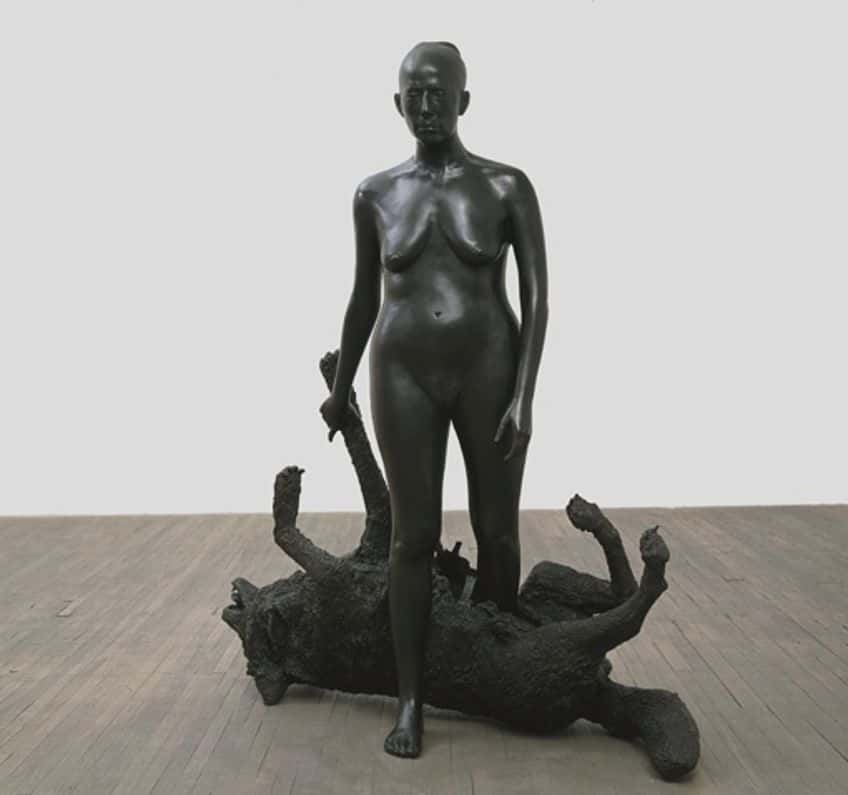
Through this sculpture, she delves into the depiction of our connection to animals and its portrayal in different periods of time. Initially starting with etchings and prints, Smith’s focus shifted towards sculpting, which she believes is the most engaging medium to convey these ideas.
Anish Kapoor (1954 – Present)
| Date of Birth | 1954 |
| Date of Death | N/A |
| Nationality | British |
| Famous Artworks | Cloud Gate (2006), Sky Mirror (2001), and ArcelorMittal Orbit (2012) |
| Performance Themes | Beauty, analogy, and the ancient |
Anish Kapoor is a British sculptor known for his large-scale, site-specific works that explore the relationship between space, form, and color. His works are characterized by their minimalist aesthetic and use of unconventional materials, such as pigmented wax, fiberglass, and stainless steel.

Kapoor’s art is informed by his interest in philosophy, spirituality, and the natural world, often creating works that arouse a feeling of amazement and wonderment. His iconic sculptures have become landmarks and tourist attractions around the world. Kapoor has been awarded numerous accolades for his contribution to contemporary art, including a knighthood in 2013, and continues to inspire and challenge audiences with his visionary approach to sculpture.
Why Is Anish Kapoor Such an Influential Contemporary Sculpture Artist?
Anish Kapoor’s sculptures challenge traditional notions of sculpture and architecture, blurring the lines between the two and creating immersive, transformative experiences for the viewer. Kapoor’s use of unconventional materials, such as pigmented wax and fiberglass, adds an extra layer of intrigue and depth to his work, creating works that are both visually stunning and conceptually complex.
Kapoor’s influence extends beyond the realm of contemporary art, with his works becoming landmarks and tourist attractions in cities around the world.
His visionary approach to sculpture has helped redefine what sculpture can be in the contemporary era, inspiring new generations of artists to push the boundaries of what is possible in the medium.
Modern Art Sculpture Example: Cloud Gate (2006)
Cloud Gate, also known as The Bean, is a monumental sculpture by the famous modern sculptor, Anish Kapoor, located in Chicago’s Millennium Park. The sculpture’s highly reflective, mirror-like surface creates a sense of transparency and ambiguity, reflecting the surrounding skyline and creating an immersive, kaleidoscopic experience for the viewer. Its elliptical shape and smooth, curvilinear form convey a sense of fluidity and motion, evoking a sense of awe and wonder. The sculpture’s form is inspired by liquid mercury, reflecting Kapoor’s interest in the natural world and the properties of materials.
Cloud Gate is a conceptual exploration of space and reflection, inviting the viewer to contemplate their place in the world and their relationship to the surrounding environment. The sculpture has become a beloved landmark and tourist attraction in Chicago, embodying Kapoor’s vision of creating transformative experiences through art.
Jeff Koons (1955 – Present)
| Date of Birth | 1955 |
| Date of Death | N/A |
| Nationality | American |
| Famous Artworks | Rabbit (1986), Puppy (1992), and Balloon Dog (1994–2000) |
| Performance Themes | Business, capitalism, mortality, and imbalances within contemporary civilization |
Jeff Koons is a famous contemporary sculptor known for his innovative and controversial approach to art-making. His work spans a variety of mediums, including sculpture, painting, and installation, and often features a bold, pop art-inspired aesthetic. Koons’ work explores themes of consumerism, mass media, and popular culture, blurring the boundaries between art and commerce.
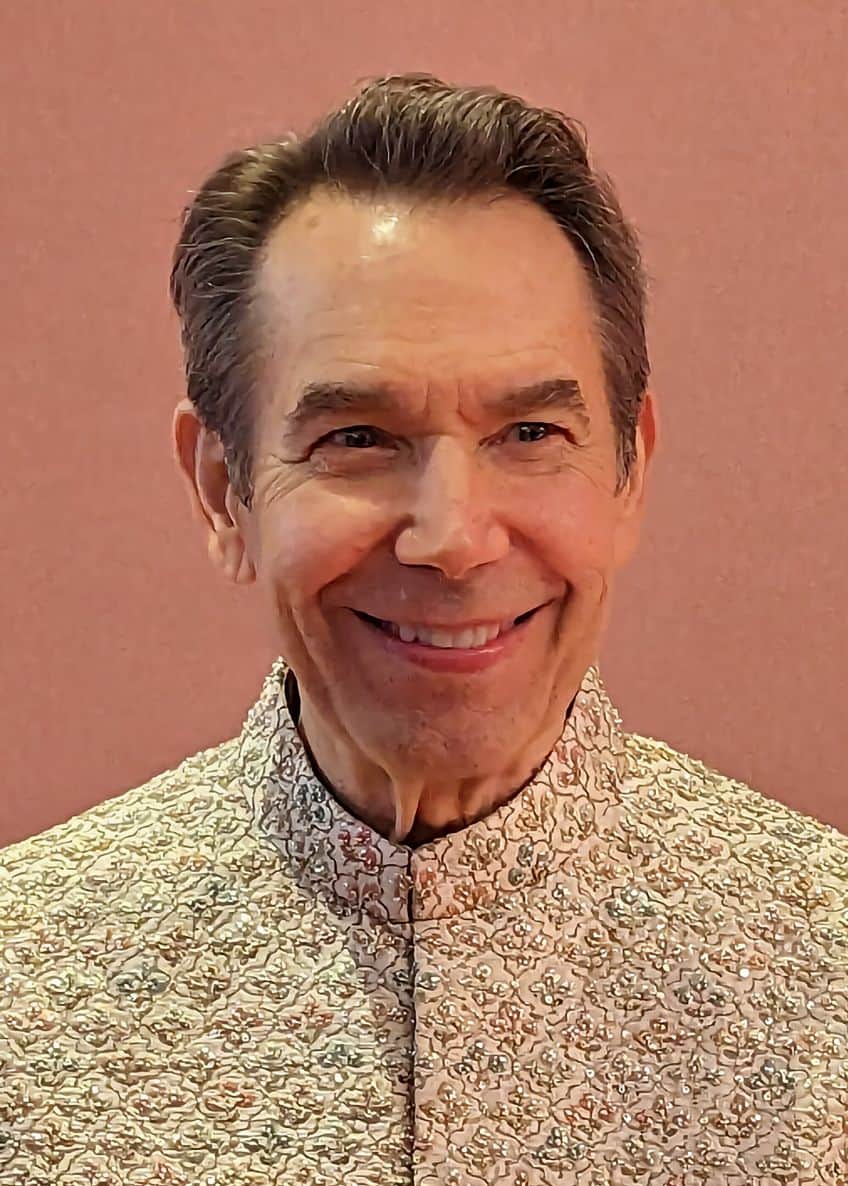
Why Is Jeff Koons Such an Influential Contemporary Sculpture Artist?
Koons’ iconic sculptures of everyday objects, such as balloon animals and household appliances, challenge traditional notions of high art and invite viewers to reconsider the value and meaning of everyday objects. Koons’ art has been exhibited in major museums and galleries worldwide and has become highly sought after by collectors, making him one of the most commercially successful artists of his generation.
Despite criticism and controversy surrounding his work, Koons continues to push the boundaries of contemporary art and inspire new generations of artists.
Famous Contemporary Sculpture Example: Balloon Dog (1994 – 2000)
Balloon Dog by Jeff Koons is a visually striking and playful sculpture that embodies the artist’s signature pop art-inspired aesthetic. The sculpture is composed of highly reflective, mirror-polished stainless steel, which creates a sense of luminosity and draws attention to its intricate, balloon-like forms.
The balloon dog is a familiar and universal image that is transformed into a work of art through Koons’ masterful use of scale, material, and technique. The sculpture’s playful and whimsical appearance belies its complex conceptual underpinnings, which explore themes of mass media, consumerism, and the commodification of art.
Jaume Plensa (1955 – Present)
| Date of Birth | 1955 |
| Date of Death | N/A |
| Nationality | Spanish |
| Famous Artworks | Crown Fountain (2004), Blake in Gateshead (1996), and Dream (2009) |
| Performance Themes | Globalization, the human condition, and memory |
Jaume Plensa is a Spanish sculptor known for his monumental public sculptures that blend technology, language, and spirituality. Plensa’s work explores the intersection of the human and divine, using materials such as steel, glass, and light to create ethereal, contemplative works. He often incorporates text and language into his sculptures, drawing on his background in literature and linguistics. His works can be found in public spaces around the world, including the United States, Spain, and Japan.

Why Is Jaume Plensa Such an Influential Contemporary Sculpture Artist?
Jaume Plensa is considered an influential contemporary sculpture artist due to his unique ability to combine innovative technology with traditional sculpting techniques. His work often explores themes of human emotion and spirituality, using language and the human form as key elements in his pieces. Plensa’s use of large-scale installations and public art has also had a significant impact on the field, bringing sculpture into public spaces and making it accessible to a wider audience.
Additionally, his work with light and sound has expanded the possibilities of sculpture and challenged traditional notions of the medium.
Modern Art Sculpture Example: Crown Fountain (2004)
Crown Fountain (2004) by Jaume Plensa is a large-scale public sculpture installation located in Millennium Park, Chicago. The piece is composed of two towering glass block towers, each measuring 50 feet tall, with an LED screen that displays images of the faces of Chicago residents.
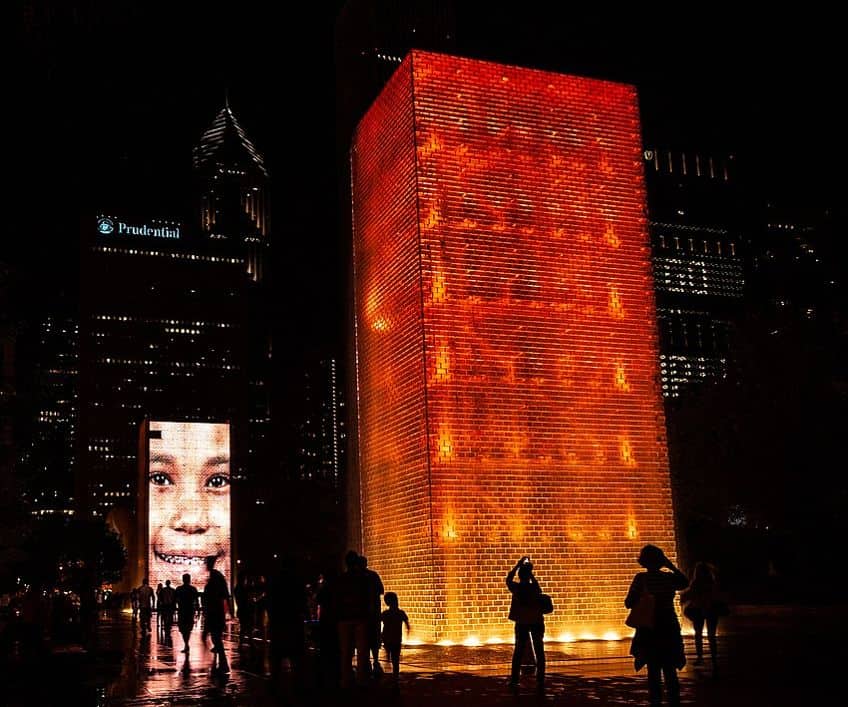
The towers flank a shallow reflecting pool and during the summer months, water cascades down the faces of the screens, creating the illusion of the faces spitting water into the pool. The artwork is both playful and interactive, inviting viewers to wade in the water and interact with the images. Plensa’s Crown Fountain celebrates the diversity of the city, reflecting on the idea of public space as a site for democratic engagement and communal gathering.
Takashi Murakami (1962 – Present)
| Date of Birth | 1962 |
| Date of Death | N/A |
| Nationality | Japan |
| Famous Artworks | My Lonesome Cowboy (1998), 3-Meter Girl (2011), and Mr. Dob (1993) |
| Performance Themes | Cuteness, innocence, the commodification of sexuality, and violence |
Takashi Murakami is a Japanese contemporary artist known for his colorful, cartoon-like sculptures and paintings that blend traditional Japanese art with contemporary pop culture. Murakami studied traditional Japanese painting before attending Tokyo National University of Fine Arts and Music, where he earned a Ph.D in nihonga (Japanese-style painting). In the 1990s, he began to merge Japanese traditional art forms with the aesthetics of anime, manga, and otaku (geek) culture, creating a style he calls “superflat.” Murakami’s work explores themes of consumerism, popular culture, and the role of art in contemporary society.

His sculptures, which often feature his signature characters, including the iconic Mr. DOB, have been exhibited in museums and galleries around the world, and he is widely recognized as one of the most important contemporary artists of his generation.
Why Is Takashi Murakami Such an Influential Contemporary Sculpture Artist?
Takashi Murakami’s work has had a profound impact on contemporary sculpture, pushing the boundaries of what is considered “high art” and exploring the relationship between popular culture and fine art. His colorful, playful sculptures, which often feature a mix of traditional Japanese and contemporary pop culture iconography, have captured the attention of audiences around the world.
Murakami’s signature style, which he calls “superflat,” has influenced a new generation of artists, and his collaborations with major brands like Louis Vuitton have brought his work to a wider audience.
His innovative approach to sculpture, blending elements of Japanese culture, anime, manga, and popular culture, has helped to redefine the possibilities of contemporary sculpture and continues to inspire new generations of artists.
Famous Contemporary Sculpture Example: My Lonesome Cowboy (1993)
My Lonesome Cowboy (1993) is a provocative and whimsical sculpture by Takashi Murakami, featuring a young boy masturbating a lasso made of his own ejaculate. The piece is crafted with meticulous attention to detail and is striking for its vivid colors and cartoon-like appearance.
The sculpture reflects Murakami’s fascination with both traditional Japanese art and contemporary pop culture, as well as his interest in exploring themes of sexuality, desire, and popular culture. My Lonesome Cowboy is a powerful example of Murakami’s ability to blend high and low culture, creating works that are both playful and profound, and that challenge traditional notions of what art should be.
Damien Hirst (1965 – Present)
| Date of Birth | 1946 |
| Date of Death | N/A |
| Nationality | British |
| Famous Artworks | The Physical Impossibility of Death in the Mind of Someone Living (1991), For the Love of God (2007) and, Verity (2012) |
| Performance Themes | Mortality, life, and decay |
Damien Hirst is a British artist known for his provocative and controversial works that challenge the boundaries of contemporary art. Hirst rose to prominence in the 1990s as part of the Young British Artists movement, gaining notoriety for his use of animals, such as sharks and cows, in formaldehyde-filled tanks.

His works explore themes of mortality, beauty, and the human condition, often employing shock tactics to challenge the viewer’s preconceptions. Hirst’s diverse body of work includes sculpture, painting, installation, and printmaking, and his use of unconventional materials, such as butterflies and pills, adds an extra layer of complexity and depth to his art. Hirst has been the subject of numerous exhibitions and retrospectives, and his work is represented in major museums and private collections around the world.
Why Is Damien Hirst Such an Influential Contemporary Sculpture Artist?
Damien Hirst has had a big impact on the art world through his provocative and boundary-pushing works. His use of unconventional materials and his exploration of themes of mortality and the human condition have challenged traditional notions of art and have sparked controversy and debate.
Hirst’s art is known for its shock value and conceptual depth, creating works that are both visually stunning and intellectually engaging.
His influence extends beyond the realm of sculpture, with his diverse body of work encompassing painting, installation, and printmaking. His daring and innovative approach to art has inspired new generations of artists to push the boundaries of what is possible in contemporary art, cementing his status as one of the most influential artists of his generation.
Modern Art Sculpture Example: Verity (2012)
Verity is a monumental sculpture by Damien Hirst located in Ilfracombe, Devon, UK. The sculpture depicts a pregnant woman holding a sword, with the skin on one side of her body peeled away to reveal the anatomy beneath. The highly detailed, anatomically accurate inner structure of the woman contrasts sharply with the smooth, white exterior of the figure, creating a sense of tension and dissonance.

The sword, held aloft in one hand, adds an extra layer of complexity and symbolism to the work, referencing themes of power, justice, and mortality. Verity is a conceptual exploration of the human body and the dichotomy between surface appearance and inner reality, inviting the viewer to contemplate their own mortality and the fragile nature of the human condition. The sculpture’s location on the harbor in Ilfracombe adds an extra layer of resonance, with the figure looking out to sea and symbolizing the connection between humanity and the natural world.
In conclusion, contemporary sculpture has evolved significantly over the past few decades, with artists constantly pushing the boundaries of traditional sculptural techniques and materials. Each of the sculptors discussed above has made significant contributions to the field, challenging our perceptions of space, form, and materiality. From the conceptual depth of Yayoi Kusama and Anish Kapoor’s works, to the bold and playful nature of Jeff Koons and Takashi Murakami’s sculptures, contemporary sculpture continues to capture the attention of audiences worldwide. These artists have not only established themselves as leading figures in the art world, but they have also inspired younger generations to continue exploring and innovating in the field of sculpture.
Take a look at our contemporary sculptors webstory here!
Frequently Asked Questions
How Has Sculpture Evolved Over the Years?
Sculpture has been a significant form of artistic expression since ancient times, with examples of sculpture dating back to ancient civilizations like Egypt, Greece, and Rome. Over the centuries, the evolution of sculpture has been marked by various movements and styles, such as the Renaissance, Baroque, and Neoclassical periods. In the 20th century, artists began to experiment with new materials and forms, leading to the development of contemporary sculpture. Today, contemporary sculpture artists continue to push the boundaries of what is possible with sculpture, using a wide range of materials and techniques to create works that challenge and inspire viewers.
What Kinds of Sculpture Art Exists?
The sculpture category of art is incredibly diverse, encompassing a wide range of styles, techniques, materials, and subject matter. From traditional marble and bronze sculptures depicting historical figures, religious icons, and mythological creatures, to contemporary works exploring abstract forms, political commentary, and environmental issues, sculpture offers a vast canvas for artists to express their creativity and vision. Whether carved, molded, cast, or assembled, sculptures can be small and intimate or monumental and imposing, inviting viewers to engage with them on multiple levels and appreciate the skill and imagination behind their creation.
What Famous Contemporary Sculptors Are There?
There are many famous contemporary artists who have gained international recognition for their innovative and thought-provoking work. One such artist is Ai Weiwei (1957 – Present), a Chinese artist and activist who works in a variety of media, including sculpture, installation, photography, and film. He is known for his bold political statements, particularly regarding human rights and censorship in China. Another notable contemporary artist is Yayoi Kusama (1929 – Present), a Japanese artist who creates colorful and immersive installations, sculptures, and paintings that explore themes of infinity, self-obliteration, and the cosmos. She is also known for her distinctive polka dot motifs and her collaborations with fashion and design brands. Other notable contemporary artists include Damien Hirst (1965 – Present), Jeff Koons (1955 – Present), and Banksy (1947 – Present), all of whom have made significant contributions to the contemporary art scene through their unique styles, concepts, and techniques.
Nicolene Burger is a South African multi-media artist, working primarily in oil paint and performance art. She received her BA (Visual Arts) from Stellenbosch University in 2017. In 2018, Burger showed in Masan, South Korea as part of the Rhizome Artist Residency. She was selected to take part in the 2019 ICA Live Art Workshop, receiving training from art experts all around the world. In 2019 Burger opened her first solo exhibition of paintings titled, Painted Mantras, at GUS Gallery and facilitated a group collaboration project titled, Take Flight, selected to be part of Infecting the City Live Art Festival. At the moment, Nicolene is completing a practice-based master’s degree in Theatre and Performance at the University of Cape Town.
In 2020, Nicolene created a series of ZOOM performances with Lumkile Mzayiya called, Evoked?. These performances led her to create exclusive performances from her home in 2021 to accommodate the mid-pandemic audience. She also started focusing more on the sustainability of creative practices in the last 3 years and now offers creative coaching sessions to artists of all kinds. By sharing what she has learned from a 10-year practice, Burger hopes to relay more directly the sense of vulnerability with which she makes art and the core belief to her practice: Art is an immensely important and powerful bridge of communication that can offer understanding, healing and connection.
Nicolene writes our blog posts on art history with an emphasis on renowned artists and contemporary art. She also writes in the field of art industry. Her extensive artistic background and her studies in Fine and Studio Arts contribute to her expertise in the field.
Learn more about Nicolene Burger and the Art in Context Team.
Cite this Article
Nicolene, Burger, “Famous Contemporary Sculptors – Explore Modern Art Sculptures.” Art in Context. April 26, 2023. URL: https://artincontext.org/famous-contemporary-sculptors/
Burger, N. (2023, 26 April). Famous Contemporary Sculptors – Explore Modern Art Sculptures. Art in Context. https://artincontext.org/famous-contemporary-sculptors/
Burger, Nicolene. “Famous Contemporary Sculptors – Explore Modern Art Sculptures.” Art in Context, April 26, 2023. https://artincontext.org/famous-contemporary-sculptors/.






